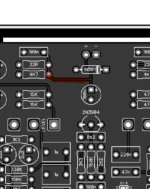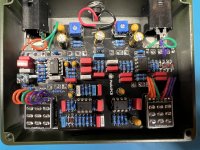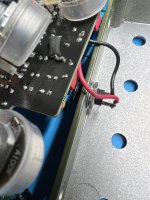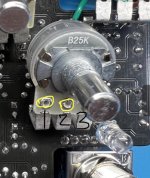Lytt Effects
Member
Ok, this one is giving me a run for my money. I built one of these already and it worked right out of the gate, with one minor issue on the green side where the LED would stay very dimly lit when bypassed. I got that issue resolved (somehow, not sure exactly), and moved on to building my second and third Pro-10s as part of a build project I’m working on. This one is build #2, and the green side is once again having issues.
The first issue arose when I attempted to add the Trimmit boards for the CLRs. The blue side went fine, but the green side did not. Long story short, I ended up breaking off a socket, along with the solder pad, which pulled up the trace, so I had to cut it. According to the trace on the board, it appeared that adding a jumper wire from the + pad to the CLR would be the fix. I did this, and it worked to get the LED to turn on when switched, but I got nothing when testing. However, the blue side worked perfectly fine. When bypassing the green side, the blue side worked as normal.
It took me a while, but I finally realized that the circuit wasn’t getting any power beyond the LED, and then it hit me: the solder pad broke off, so there was no connection to R129 (22R) in the power section, therefore no power to the green side circuit. When I had it unboxed, I then placed a jumper from the CLR to R22 on the green side, and everything worked. Yay! So, to make the fix, I removed C300 (100uF) to place a new one in to utilize the long positive lead. I then placed some shrink on the lead, positioned it across the CLR pin and 22R, and soldered in place. Not the cleanest fix, but it worked, and I tested once again before boxing.
But my excitement was short lived. I boxed the unit up, went to test it, and when I engaged the green side: only noise. I can only describe it as high-pitched whirling. I then pulled everything back out thinking something weird went on when I boxed it, tested it, and it worked perfectly fine. I then re-boxed it, tested it, and again, whirling noise. I bypassed the green side and it worked, engaged the blue side and it worked, but when engaging the green side, nothing but noise.
I then unboxed the unit again, tested, and it worked, so I figured it was a grounding issue. I then tested it with just the output jack connected to the enclosure, and there lies the issue. When the output jack is secured to the enclosure, the green side does not work.
Can anyone pinpoint what might be going on? I will attach pictures of the build, as well as a screenshot of the initial trace that was broken, and how it was eventually rectified. I’m probably missing something obvious here, but I’m in galaxy brain mode after troubleshooting for a couple hours on this already.





The first issue arose when I attempted to add the Trimmit boards for the CLRs. The blue side went fine, but the green side did not. Long story short, I ended up breaking off a socket, along with the solder pad, which pulled up the trace, so I had to cut it. According to the trace on the board, it appeared that adding a jumper wire from the + pad to the CLR would be the fix. I did this, and it worked to get the LED to turn on when switched, but I got nothing when testing. However, the blue side worked perfectly fine. When bypassing the green side, the blue side worked as normal.
It took me a while, but I finally realized that the circuit wasn’t getting any power beyond the LED, and then it hit me: the solder pad broke off, so there was no connection to R129 (22R) in the power section, therefore no power to the green side circuit. When I had it unboxed, I then placed a jumper from the CLR to R22 on the green side, and everything worked. Yay! So, to make the fix, I removed C300 (100uF) to place a new one in to utilize the long positive lead. I then placed some shrink on the lead, positioned it across the CLR pin and 22R, and soldered in place. Not the cleanest fix, but it worked, and I tested once again before boxing.
But my excitement was short lived. I boxed the unit up, went to test it, and when I engaged the green side: only noise. I can only describe it as high-pitched whirling. I then pulled everything back out thinking something weird went on when I boxed it, tested it, and it worked perfectly fine. I then re-boxed it, tested it, and again, whirling noise. I bypassed the green side and it worked, engaged the blue side and it worked, but when engaging the green side, nothing but noise.
I then unboxed the unit again, tested, and it worked, so I figured it was a grounding issue. I then tested it with just the output jack connected to the enclosure, and there lies the issue. When the output jack is secured to the enclosure, the green side does not work.
Can anyone pinpoint what might be going on? I will attach pictures of the build, as well as a screenshot of the initial trace that was broken, and how it was eventually rectified. I’m probably missing something obvious here, but I’m in galaxy brain mode after troubleshooting for a couple hours on this already.








